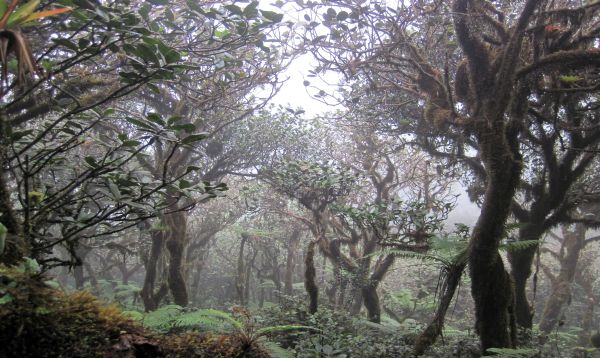San Juan, Puerto Rico - In as few as 25 years, climate change could shrink and dry 60-80% of Western Hemisphere cloud forests, finds a study published April 17, 2019.
If greenhouse gas emissions continue increasing as they have been, 90% of Western Hemisphere cloud forests would be affected as early as 2060. The current cloud and frost environment of the highly diverse alpine ecosystems above these equatorial cloud forests, known as páramo, will nearly disappear.
Cloud forests are the misty forests found high on tropical mountains. Frequently cloud-enshrouded, many are reminiscent of fairy-tale forests, having twisted, stunted old trees covered in moss and ferns. But their importance is real.
Their trees, and the plants and lichens living on them, intercept water vapor that can supply 75% of the stream water in drier places. And they are among the most biodiverse ecosystems on Earth. Thousands of unique species evolved where fog and mist have created strikingly wetter habitat isolated on mountains.
 |
| Tourists traverse the canopy bridge at the Monteverde Cloud Forest Reserve in Costa Rica. (Photo: Kate Webster) |
In the Caribbean, the U.S. National Forest El Yunque harbors the threatened Elfin Woods Warbler, found only in Puerto Rico’s mountains. It is named after the mossy, mysterious "elfin" cloud forests on mountaintops. In Central America, tourists from around the world visit the Monteverde Cloud Forest Reserve in Costa Rica. While traversing treetop walkways there, they can feel the strength of trade winds forcing humid air up mountains and hear the ethereal songs of Nightingale Thrushes. All of these cloud forests will be affected from fewer or thinner clouds that form at higher elevations, and from drier conditions.
This study is the first to quantify these potential changes across continents. To do so, scientists from U.S. Forest Service labs in Puerto Rico and Fort Collins, Colorado, and from Colorado State University developed a new approach. They mapped and projected how climate change would affect the feature that cloud forest species are uniquely adapted to: cloud immersion.
The team mapped current cloud forest areas across the Western Hemisphere with data on climate and mountain size and observations from dozens of ecological studies, including historical ones dating back 50 to 60 years. They then projected cloud forest extent and relative humidity, a proxy for cloud frequency and density, with scenarios for future greenhouse gas emissions and associated climate conditions.
Before this research, studies from a handful of sites suggested that cloud immersion would increase in some cloud forests but decline in others. Cloud immersion might increase because air humidity will increase over warming oceans, implying thicker clouds forming at lower elevations and cloudier forests. Cloud immersion might decrease because increased temperatures over land could force air to travel further up mountains before it cools enough to form clouds, reducing cloud forest area and cloudiness.
The fates of the rest of cloud forests were unknown. Global climate modeling is too coarse to target effects on cloud forests. This new study found that cloud immersion would increase for only about 1% of all Western Hemisphere cloud forests, in only a few regions of South America. Declines in cloud immersion would dominate.
Click HERE to read the study published in the journal PLOS ONE. It also analyzed deforestation in cloud forest areas and found that some of the cloud forests that would be least affected by climate change are the ones that are either most deforested or least protected from deforestation.
Source: E.H. Helmer, E.A. Gerson, L. Scott Baggett, Benjamin Bird, Thomas S. Ruzycki, Shannon M. Voggesser. 2019. Neotropical cloud forests and páramo to contract and dry from declines in cloud immersion and frost.


